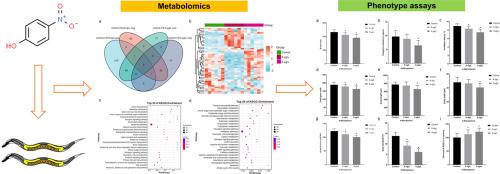当前位置:
X-MOL 学术
›
Journal of Environmental Sciences
›
论文详情
Our official English website, www.x-mol.net, welcomes your
feedback! (Note: you will need to create a separate account there.)
4-Nitrophenol at environmentally relevant concentrations mediates reproductive toxicity in Caenorhabditis elegans via metabolic disorders-induced estrogen signaling pathway
Journal of Environmental Sciences ( IF 5.9 ) Pub Date : 2023-10-03 , DOI: 10.1016/j.jes.2023.09.032 Jia Wang 1 , Jiechen Yin 1 , Danhong Peng 2 , Xiaoqian Zhang 3 , Zhouhong Shi 3 , Weixi Li 1 , Yingchi Shi 1 , Mingjun Sun 1 , Nan Jiang 1 , Beijing Cheng 1 , Xingchen Meng 1 , Ran Liu 1
Journal of Environmental Sciences ( IF 5.9 ) Pub Date : 2023-10-03 , DOI: 10.1016/j.jes.2023.09.032 Jia Wang 1 , Jiechen Yin 1 , Danhong Peng 2 , Xiaoqian Zhang 3 , Zhouhong Shi 3 , Weixi Li 1 , Yingchi Shi 1 , Mingjun Sun 1 , Nan Jiang 1 , Beijing Cheng 1 , Xingchen Meng 1 , Ran Liu 1
Affiliation

|
4-Nitrophenol (4-NP), as a toxic and refractory pollutant, has generated significant concern due to its adverse effects. However, the potential toxic effects and mechanism remained unclear. In this study, the reproduction, development, locomotion and reactive oxygen species (ROS) production of were investigated to evaluate the 4-NP toxicity. We used metabolomics to assess the potential damage mechanisms. The role of metabolites in mediating the relationship between 4-NP and phenotypes was examined by correlation and mediation analysis. 4-NP (8 ng/L and 8 µg/L) caused significant reduction of brood size, ovulation rate, total germ cells numbers, head thrashes and body bends, and an increase in ROS. However, the oosperm numbers in uterus, body length and body width were decreased in 8 µg/L. Moreover, 36 differential metabolites were enriched in the significant metabolic pathways, including lysine biosynthesis, β-alanine metabolism, tryptophan metabolism, pentose phosphate pathway, pentose and glucuronate interconversions, amino sugar and nucleotide sugar metabolism, starch and sucrose metabolism, galactose metabolism, propanoate metabolism, glycerolipid metabolism, and estrogen signaling pathway. The mechanism of 4-NP toxicity was that oxidative stress caused by the perturbation of amino acid, which had effects on energy metabolism through disturbing carbohydrate and lipid metabolism, and finally affected the estrogen signaling pathway to exert toxic effects. Moreover, correlation and mediation analysis showed glycerol-3P, glucosamine-6P, glucosamine-1P, UDP-galactose, L-aspartic acid, and uracil were potential markers for the reproduction and glucose-1,6P2 for developmental toxicity. The results provided insight into the pathways involved in the toxic effects caused by 4-NP and developed potential biomarkers to evaluate 4-NP toxicity.
中文翻译:

环境相关浓度的 4-硝基苯酚通过代谢紊乱诱导的雌激素信号通路介导秀丽隐杆线虫的生殖毒性
4-硝基苯酚(4-NP)作为一种有毒、难降解的污染物,因其不良影响而引起了人们的广泛关注。然而,潜在的毒性作用和机制仍不清楚。本研究通过研究 4-NP 的繁殖、发育、运动和活性氧 (ROS) 产生来评估 4-NP 的毒性。我们使用代谢组学来评估潜在的损害机制。通过相关性和中介分析检查代谢物在介导 4-NP 和表型之间关系中的作用。 4-NP(8 ng/L 和 8 µg/L)导致巢大小、排卵率、生殖细胞总数、头部剧烈运动和身体弯曲显着减少,并且 ROS 增加。然而,子宫内受精卵数量、体长和体宽均减少8μg/L。此外,重要代谢途径中富集了36种差异代谢物,包括赖氨酸生物合成、β-丙氨酸代谢、色氨酸代谢、磷酸戊糖途径、戊糖和葡萄糖醛酸相互转化、氨基糖和核苷酸糖代谢、淀粉和蔗糖代谢、半乳糖代谢、丙酸代谢、甘油脂代谢和雌激素信号通路。 4-NP的毒性机制是氨基酸扰动引起氧化应激,通过干扰糖类和脂类代谢影响能量代谢,最终影响雌激素信号通路发挥毒性作用。此外,相关性和中介分析显示甘油-3P、葡萄糖胺-6P、葡萄糖胺-1P、UDP-半乳糖、L-天冬氨酸和尿嘧啶是生殖毒性的潜在标志物,葡萄糖-1,6P2 是发育毒性的潜在标志物。 结果提供了对 4-NP 引起的毒性作用所涉及的途径的深入了解,并开发了评估 4-NP 毒性的潜在生物标志物。
更新日期:2023-10-03
中文翻译:

环境相关浓度的 4-硝基苯酚通过代谢紊乱诱导的雌激素信号通路介导秀丽隐杆线虫的生殖毒性
4-硝基苯酚(4-NP)作为一种有毒、难降解的污染物,因其不良影响而引起了人们的广泛关注。然而,潜在的毒性作用和机制仍不清楚。本研究通过研究 4-NP 的繁殖、发育、运动和活性氧 (ROS) 产生来评估 4-NP 的毒性。我们使用代谢组学来评估潜在的损害机制。通过相关性和中介分析检查代谢物在介导 4-NP 和表型之间关系中的作用。 4-NP(8 ng/L 和 8 µg/L)导致巢大小、排卵率、生殖细胞总数、头部剧烈运动和身体弯曲显着减少,并且 ROS 增加。然而,子宫内受精卵数量、体长和体宽均减少8μg/L。此外,重要代谢途径中富集了36种差异代谢物,包括赖氨酸生物合成、β-丙氨酸代谢、色氨酸代谢、磷酸戊糖途径、戊糖和葡萄糖醛酸相互转化、氨基糖和核苷酸糖代谢、淀粉和蔗糖代谢、半乳糖代谢、丙酸代谢、甘油脂代谢和雌激素信号通路。 4-NP的毒性机制是氨基酸扰动引起氧化应激,通过干扰糖类和脂类代谢影响能量代谢,最终影响雌激素信号通路发挥毒性作用。此外,相关性和中介分析显示甘油-3P、葡萄糖胺-6P、葡萄糖胺-1P、UDP-半乳糖、L-天冬氨酸和尿嘧啶是生殖毒性的潜在标志物,葡萄糖-1,6P2 是发育毒性的潜在标志物。 结果提供了对 4-NP 引起的毒性作用所涉及的途径的深入了解,并开发了评估 4-NP 毒性的潜在生物标志物。






























 京公网安备 11010802027423号
京公网安备 11010802027423号